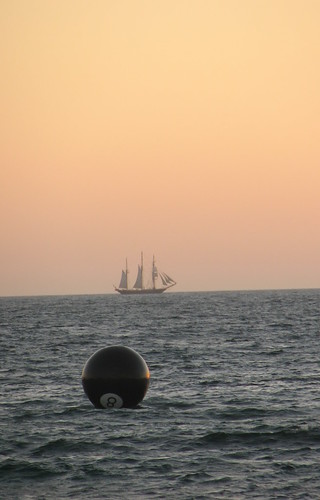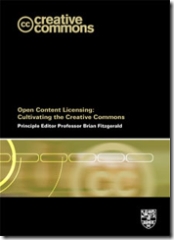300: An Online Marketing Hit
There’s been a lot of talk about 300, which is now, financially at least, the first big blockbuster of 2007. Leaving aside Iran’s outrage at the film’s depiction of their history, one of the most interesting elements of the film was the clever and canny marketing strategies which found success in online arenas where many others have tried, but failed. Deborah Netburn’s article in the LA Times points out that 300 succeeded where others (most notably Snakes on a Plane) only appeared to work until the people voted with their feet at the box office:
Fanboy buzz is not enough to sell a film — “Snakes on a Plane,” anyone? — but Garabedian points out that while the online community was obsessively talking about “Snakes” they were ultimately making fun of it. The people who were driving the chatter around “300” were genuinely excited about the film, especially the way it looked. And after Comic-Con, Warner Bros. marketing department made sure that the fanboys got the usual dribs and drabs of movie art and trailers just to keep their excitement up.
The marketing folks also took full advantage of MySpace. There was of course the requisite MySpace page for the film (now standard for all movies) — featuring a ferocious looking muscle man in a metal helmet plus tons of video clips, wallpapers and links to the film’s official website. But the stroke of genius came when the studio sponsored a feature upgrade to the site that told users they could store 300 photos on their profile thanks to the movie “300.” (Previously the limit had been 12). That started Jan. 2 and was incredibly popular with teens. The result was billions of ad impressions and 8 million viewings of the trailer. Is it any wonder that the 52% of the people who saw “300” were under 25?
There are also mundane reasons “300” might have done well. A generally warm weekend across the country encouraged people to get out of the house and brave long lines, and no other major film was released against “300,” so it didn’t have much competition. And while the critics have been lukewarm on the film — faulting it for poor dialogue and a thin story — nobody has said anything negative about the visuals. And to a generation of kids who have grown up with the lush worlds of video games, “300” was a familiar visual masterpiece.
The ‘300 images’ idea is definitely a clever one, and shows that marketing online really has to think outside the box of traditional hype-building.
On a differrent note, 300 is also interesting in that it was entirely edited on Apple Macs. For the tech details, visit the Raw Feed.
links for 2007-03-14
-
“Professors aren’t the only ones making podcasts for the purpose of education. Their students are being required to create them …” (Not exactly new).
-
“EdPod presents a mix of education stories, from early childhood to the end of secondary school. … EdPod examines new education ideas, and asks whether things could or should be done differently. … EdPod brings you the latest ideas about learning.”
links for 2007-03-13
-
“The stereotypical image of gamers as spotty, teenage boys is a long way off the mark, according to new research showing the average gamer is in their 30s and just as likely to be a woman.”
-
“BigPond today launched Australia’s first major corporate presence in the online virtual world, Second Life, with the unveiling of ‘The Pond’. …features islands with uniquely Australian themes and recreations of iconic Australian landmarks…”
-
Jane McGonigal, Ian Bogost, and Mia Consalvo choose and run through the top ten research findings in Game Studies in the past year. So much more fun than a literature review … 🙂
-
“If Twitter continues its meteoric rise, then we may well be witnessing a changing of the guard. That doesn’t mean blogging as we know it will go away. But it will surely morph in Twitter’s wake if a big shift is underway.” (Rubel stakes a claim as Twitte
Sculpture by the Sea 2007
Last night Emily and I went down to Cottesloe beach to see the amazing Sculpture by the Sea exhibition which runs until next Sunday (March 18th). The mix of amazing art – some cute, some inspiring, and some just really, really big – and the casual atmosphere of the beach is a winning combination to my mind. If you’re living in or around Perth, I thoroughly recommend you ensure you get down to Cott before the show ends; if you’re a photographer, sunset is definitely your friend!
I’ve uploaded a set of my best photos to Flickr which I hope you’ll take a peak at, but I thought I’d tempt you with these few images:

This gigantic sculpture of what looks rather like a recycle symbol is one of the most popular pieces. People like having their photos taken under these energetic arches!
Bronzed, pregnant and enjoying a marvellous sunset; how very Australian!
And as fortune would have it, as I was lining up this shot of the giant eight-ball which is tethered just off the beach, the tall-ship Leeuwin sailed across the horizon!
Open Content Licensing: Cultivating the Creative Commons
 Creative Commons Australia announced today the release of Open Content Licensing: Cultivating the Creative Commons, a book collecting a number of essays about copyright and open content licensing in teh Australian context. It’s edited by Brian Fitzgerarld, who leads Australia’s CC project. It draws on a 2005 conference, but given the speed at which Australian copyright laws change (glacier speed), it’s findings and commentaries are entirely in keeping with the current Australian copyright landscape.
Creative Commons Australia announced today the release of Open Content Licensing: Cultivating the Creative Commons, a book collecting a number of essays about copyright and open content licensing in teh Australian context. It’s edited by Brian Fitzgerarld, who leads Australia’s CC project. It draws on a 2005 conference, but given the speed at which Australian copyright laws change (glacier speed), it’s findings and commentaries are entirely in keeping with the current Australian copyright landscape.
The book can either be purchased in hardcopy from Sydney University Press or individual articles are available for download from Sydney’s eScholarship Repository.
Given the many confusing layers of copyright law in Australia, I think this book will prove very useful in navigating these licensing waters both for those in creative industries and educators grappling with these issues.
links for 2007-03-12
-
Yesterday – 10th March, 2007 – marked the tenth anniversary of the first episode of Buffy the Vampire Slayer!
-
Interesting look at non-digital archives in a research cultures increasingly digitally-based: “Material that is not digitized risks being neglected as it would not have been in the past, virtually lost to the great majority of potential users.”
-
“As younger people reveal their private lives on the Internet, the older generation looks on with alarm and misapprehension not seen since the early days of rock and roll. The future belongs to the uninhibited.” (Gen.com?)
-
“…Hollywood’s public virulence toward YouTube continues to grow, it’s a more complicated story. Many studios, labels and diskeries are busy taking full advantage of the ever growing promotional power of YouTube, particularly among the younger 18-24 demo
-
A photo-essay looking at some of the most famous manipulated photos, from the erasure of Trotksy in photos of Lenin to Reuter’s photographer Adnan Hajj’s photoshopping of Iraqi warzones.
-
With the ongoing rise in online dating sites, a new photography and photo-manipulation industry has emerged focused on getting those online profile pictures as good (or better) as they can be!
My Second Life: Impressive SL Mystery Machinima
Here’s the blurb from Douglas Gayeton’s impressively edited, Second Life machinima short:
In January 2007, a man named Molotov Alva, dissapeared from his Californian home. Recently, a series of video dispatches by a Traveler of the same name have appeared within a popular online world called Second Life. Filmmaker Douglas Gayeton came across these video dispatches and put them together into a documentary of seven episodes.
And here’s the first episode:
It’s very well edited, telling a great story, and selling both the filmic potential of machinima based in Second Life, and the value of a good story in any medium. For educators using machinima to teach editing skills, and other machinima makers looking for great examples, check this series out. For everyone else: it’s a good story, so why not click the great big play button? [Via Boing Boing]
It’s a Small World After All: From Wired’s Minifesto to the Twitterati
Apparently small is the new black. This month’s Wired Magazine contains a Minifesto, celebrating the coolness of all things mini, from meals to media:
Today, media snacking is a way of life. In the morning, we check news and tap out emails on our laptops. At work, we graze all day on videos and blogs. Back home, the giant HDTV is for 10-course feasting – say, an entire season of 24. In between are the morsels that fill those whenever minutes, as your mobile phone carrier calls them: a 30-second game on your Nintendo DS, a 60-second webisode on your cell, a three-minute podcast on your MP3 player.
From YouTube’s clip culture to Apple’s iTunes (not iAlbums), it seems for the time being smaller is, in fact, better! In the world of social software, the coolest and probably the smallest is Twitter, which allows users to post entries of no more than 140 characters, sent in from the web, IM or text message and being sent out via these same three platforms to your Twitter friends. Twitter has some impressive parents, including Evan Williams (who started Blogger before is was sold to Google) and the other Obvious folk. I’ve experimented with Twitter for the past few days, and I can see the appeal of its immediacy, and the fact that you really can’t take up much time with so little space to type! From the larger blogosphere, Jill Walker has been thinking about her Twittering in terms of blogging, noting similarities and differences:
…there’s something very satisfying about logging your days like that and seeing what others are up to. It’s a blog at a different scale than this one, in a way, very short posts, but far more frequent…
The logging aspect is quite addictive, and despite the brevity of posts, reading just a few Twitters seems to build quite an intimate picture of someone. Ross Mayfield in his post ‘Twitter Tips the Tuna’ gives this succinct explanation of Twitter:
Twitter, in a nutshell, is mobile social software that lets you broadcast and receive short messages with your social network. You can use it with SMS (sending a message to 40404), on the web or IM. A darn easy API has enabled other clients such as Twitterific for the Mac. Twitter is Continuous Partial Presence, mostly made up of mundane messages in answer to the question, “what are you doing?” A never-ending steam of presence messages prompts you to update your own. Messages are more ephemeral than IM presence — and posting is of a lower threshold, both because of ease and accessibility, and the informality of the medium.
I think that notion of ‘Continuous Partial Presence’ may very well be the core of Twitter. Mayfield goes on to argue that Twitter is peaking, with the uptake rate getting higher and higher, with everyone from Joi Ito to the BBC staking their claim as Twitterati. Indeed, as Steve Rubel notes, even John Edwards who is once again campaigning to be the Democrat candidate in the US presidential elections, is using Twitter to keep in touch with his supporters.
While there are probably a lot of people who’ll see Twitter as the icon of procrastination (and I can see their point!), Liz Lawley responds to criticisms of Twitter, pointing out that these ephemeral tidbits can actually be quite important:
The first criticizes the triviality of the content. But asking “who really cares about that kind of mindless trivia about your day” misses the whole point of presence. This isn’t about conveying complex theory–it’s about letting the people in your distributed network of family and friends have some sense of where you are and what you’re doing. And we crave this, I think. When I travel, the first thing I ask the kids on the phone when I call home is “what are you doing?” Not because I really care that much about the show on TV, or the homework they’re working on, but because I care about the rhythms and activities of their days. No, most people don’t care that I’m sitting in the airport at DCA, or watching a TV show with my husband. But the people who miss being able to share in day-to-day activity with me–family and close friends–do care.
The second type of criticism is that the last thing we need is more interruptions in our already discontinuous and partially attentive connected worlds. What’s interesting to me about Twitter, though, is that it actually reduces my craving to surf the web, ping people via IM, and cruise Facebook. I can keep a Twitter IM window open in the background, and check it occasionally just to see what people are up to. There’s no obligation to respond, which I typically feel when updates come from individuals via IM or email. Or I can just check my text messages or the web site when I feel like getting a big picture of what my friends are up to.
So, for Lawley, it would appear that everyone has their own Twitterati who are more likely to be family and friends than anyone else. Thanks once again to Steve Rubel, there’s now a basic Twitter Search, so if you’re not using it already, why not explore a little and decide who might be in your Twitterati? 😉 (And feel free to add me, if you like.)
Welcome to TamaLeaver dot Net!
I’ve been testing and tweaking this blog for almost a month now, so I thought it was time to declare Tama Leaver dot Net open for blogging business! In the coming months (or years … or maybe more) I’ll be writing here about my thoughts on digital culture (whatever that might mean). I’m very interested in the world of blogging per se, as well as social software more generally from podcasts to YouTube, del.icio,us, Flickr and so forth.
In my professional life I’m currently working as an Associate Lecturer (Higher Education Development) at the University of Western Australia’s Centre for the Advancement of Teaching and Learning, and have previous worked in both Communication Studies and English and Cultural Studies also at UWA.
This blog is the successor to Ponderance, my previous Blogger blog, so if you’re after something before March 2007, it’s probably archived there. I blogged at Ponderance for almost four years, but I decided to migrate here in order to use my own WordPress installation and customise everything more fully that Blogger could allow.
I thought I’d also use this welcome entry to signpost my other current activities and collections so they can be easily located if you were actually looking for something more specific:-
[X] My del.icio.us bookmarks – Each day at 8am Perth time (or 9am during daylight saving; midnight GMT) a post is automatically generated and appears here with a list of my annotated bookmarks from the previous 24 hours. To explore my full bookmark collection, either scroll down on the main blog page and there’s a clickable tagcloud (a list of the frequently used tags I’ve added to my bookmarks) or go to my del.icio.us page.
[X] My Flickr photos – My latest five photos posted to Flickr appear on the right sidebar under my blogroll or you can explore them all in my Flickr photographs.
[X] Tama’s eLearning Blog – Part of the wonderful edublogs.org network, this blog is focused on issues about issues about using technology, web2.0 and other ‘eLearning’ ideas as part of a range of learning and teaching tools and strategies in higher education. Occasionally I’ll cross-post items both here and to my eLearning blog, but for the most part my eLearning thoughts will be posted in my edublog.
[X] Tama Talks Blog – Which is part of the UWA postgraduate community social software system MyResearchSpace. The blog is written primarily for that community and explores why blogging matters to postgraduates.
(If you’re subscribed to the feed from my previous blog, Ponderance, I’ve automatically updated feedburner to re-direct the to the feed from Tama Leaver dot Net, which is replacing Ponderance. If you’re still confused, see Ponderance’s retirement announcement.)
Any questions or comments? 🙂 They’re always welcome.
links for 2007-03-10
-
It’s now possible to run Linux on an iPod with video!
-
“Captain America, a Marvel Entertainment superhero, is fatally shot by a sniper in the 25th issue of his eponymous comic, which arrived in stores yesterday. The assassination ends the sentinel of liberty’s fight for right, which began in 1941.”
-
“An ethical code to prevent humans abusing robots, and vice versa, is being drawn up by South Korea. The Robot Ethics Charter will cover standards for users and manufacturers and will be released later in 2007.”


